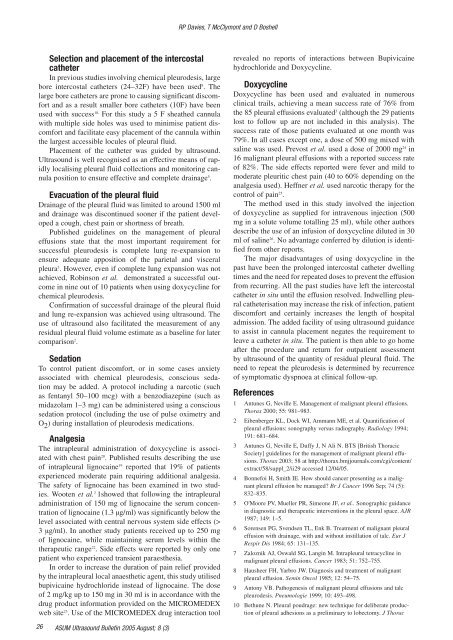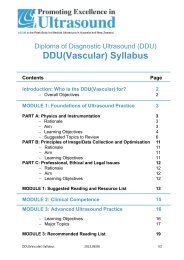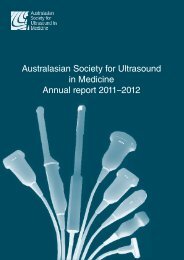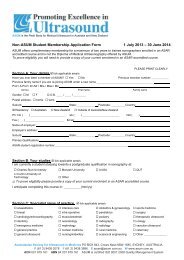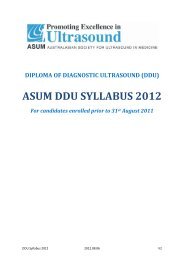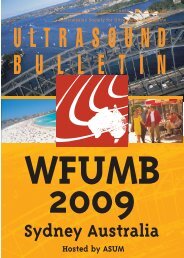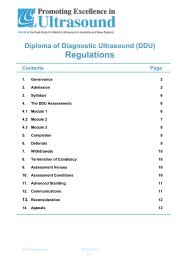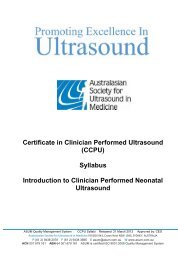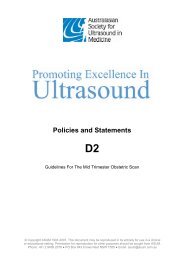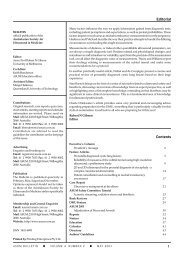Volume 8 Issue 3 - Australasian Society for Ultrasound in Medicine
Volume 8 Issue 3 - Australasian Society for Ultrasound in Medicine
Volume 8 Issue 3 - Australasian Society for Ultrasound in Medicine
Create successful ePaper yourself
Turn your PDF publications into a flip-book with our unique Google optimized e-Paper software.
RP Davies, T McClymont and D BoshellSelection and placement of the <strong>in</strong>tercostalcatheterIn previous studies <strong>in</strong>volv<strong>in</strong>g chemical pleurodesis, largebore <strong>in</strong>tercostal catheters (24–32F) have been used 8 . Thelarge bore catheters are prone to caus<strong>in</strong>g significant discom<strong>for</strong>tand as a result smaller bore catheters (10F) have beenused with success 18. For this study a 5 F sheathed cannulawith multiple side holes was used to m<strong>in</strong>imise patient discom<strong>for</strong>tand facilitate easy placement of the cannula with<strong>in</strong>the largest accessible locules of pleural fluid.Placement of the catheter was guided by ultrasound.<strong>Ultrasound</strong> is well recognised as an effective means of rapidlylocalis<strong>in</strong>g pleural fluid collections and monitor<strong>in</strong>g cannulaposition to ensure effective and complete dra<strong>in</strong>age 5 .Evacuation of the pleural fluidDra<strong>in</strong>age of the pleural fluid was limited to around 1500 mland dra<strong>in</strong>age was discont<strong>in</strong>ued sooner if the patient developeda cough, chest pa<strong>in</strong> or shortness of breath.Published guidel<strong>in</strong>es on the management of pleuraleffusions state that the most important requirement <strong>for</strong>successful pleurodesis is complete lung re-expansion toensure adequate apposition of the parietal and visceralpleura 3 . However, even if complete lung expansion was notachieved, Rob<strong>in</strong>son et al. demonstrated a successful outcome<strong>in</strong> n<strong>in</strong>e out of 10 patients when us<strong>in</strong>g doxycycl<strong>in</strong>e <strong>for</strong>chemical pleurodesis.Confirmation of successful dra<strong>in</strong>age of the pleural fluidand lung re-expansion was achieved us<strong>in</strong>g ultrasound. Theuse of ultrasound also facilitated the measurement of anyresidual pleural fluid volume estimate as a basel<strong>in</strong>e <strong>for</strong> latercomparison 2 .SedationTo control patient discom<strong>for</strong>t, or <strong>in</strong> some cases anxietyassociated with chemical pleurodesis, conscious sedationmay be added. A protocol <strong>in</strong>clud<strong>in</strong>g a narcotic (suchas fentanyl 50–100 mcg) with a benzodiazep<strong>in</strong>e (such asmidazolam 1–3 mg) can be adm<strong>in</strong>istered us<strong>in</strong>g a conscioussedation protocol (<strong>in</strong>clud<strong>in</strong>g the use of pulse oximetry andO 2 ) dur<strong>in</strong>g <strong>in</strong>stallation of pleurodesis medications.AnalgesiaThe <strong>in</strong>trapleural adm<strong>in</strong>istration of doxycycl<strong>in</strong>e is associatedwith chest pa<strong>in</strong> 20 . Published results describ<strong>in</strong>g the useof <strong>in</strong>trapleural lignoca<strong>in</strong>e 19 reported that 19% of patientsexperienced moderate pa<strong>in</strong> requir<strong>in</strong>g additional analgesia.The safety of lignoca<strong>in</strong>e has been exam<strong>in</strong>ed <strong>in</strong> two studies.Wooten et al. 2 1showed that follow<strong>in</strong>g the <strong>in</strong>trapleuraladm<strong>in</strong>istration of 150 mg of lignoca<strong>in</strong>e the serum concentrationof lignoca<strong>in</strong>e (1.3 μg/ml) was significantly below thelevel associated with central nervous system side effects (>3 μg/ml). In another study patients received up to 250 mgof lignoca<strong>in</strong>e, while ma<strong>in</strong>ta<strong>in</strong><strong>in</strong>g serum levels with<strong>in</strong> thetherapeutic range 22 . Side effects were reported by only onepatient who experienced transient paraesthesia.In order to <strong>in</strong>crease the duration of pa<strong>in</strong> relief providedby the <strong>in</strong>trapleural local anaesthetic agent, this study utilisedbupivica<strong>in</strong>e hydrochloride <strong>in</strong>stead of lignoca<strong>in</strong>e. The doseof 2 mg/kg up to 150 mg <strong>in</strong> 30 ml is <strong>in</strong> accordance with thedrug product <strong>in</strong><strong>for</strong>mation provided on the MICROMEDEXweb site 23 . Use of the MICROMEDEX drug <strong>in</strong>teraction toolrevealed no reports of <strong>in</strong>teractions between Bupivica<strong>in</strong>ehydrochloride and Doxycycl<strong>in</strong>e.Doxycycl<strong>in</strong>eDoxycycl<strong>in</strong>e has been used and evaluated <strong>in</strong> numerouscl<strong>in</strong>ical trails, achiev<strong>in</strong>g a mean success rate of 76% fromthe 85 pleural effusions evaluated 3 (although the 29 patientslost to follow up are not <strong>in</strong>cluded <strong>in</strong> this analysis). Thesuccess rate of those patients evaluated at one month was79%. In all cases except one, a dose of 500 mg mixed withsal<strong>in</strong>e was used. Prevost et al. used a dose of 2000 mg 24 <strong>in</strong>16 malignant pleural effusions with a reported success rateof 82%. The side effects reported were fever and mild tomoderate pleuritic chest pa<strong>in</strong> (40 to 60% depend<strong>in</strong>g on theanalgesia used). Heffner et al. used narcotic therapy <strong>for</strong> thecontrol of pa<strong>in</strong> 25 .The method used <strong>in</strong> this study <strong>in</strong>volved the <strong>in</strong>jectionof doxycycl<strong>in</strong>e as supplied <strong>for</strong> <strong>in</strong>travenous <strong>in</strong>jection (500mg <strong>in</strong> a solute volume totall<strong>in</strong>g 25 ml), while other authorsdescribe the use of an <strong>in</strong>fusion of doxycycl<strong>in</strong>e diluted <strong>in</strong> 30ml of sal<strong>in</strong>e 26 . No advantage conferred by dilution is identifiedfrom other reports.The major disadvantages of us<strong>in</strong>g doxycycl<strong>in</strong>e <strong>in</strong> thepast have been the prolonged <strong>in</strong>tercostal catheter dwell<strong>in</strong>gtimes and the need <strong>for</strong> repeated doses to prevent the effusionfrom recurr<strong>in</strong>g. All the past studies have left the <strong>in</strong>tercostalcatheter <strong>in</strong> situ until the effusion resolved. Indwell<strong>in</strong>g pleuralcatheterisation may <strong>in</strong>crease the risk of <strong>in</strong>fection, patientdiscom<strong>for</strong>t and certa<strong>in</strong>ly <strong>in</strong>creases the length of hospitaladmission. The added facility of us<strong>in</strong>g ultrasound guidanceto assist <strong>in</strong> cannula placement negates the requirement toleave a catheter <strong>in</strong> situ. The patient is then able to go homeafter the procedure and return <strong>for</strong> outpatient assessmentby ultrasound of the quantity of residual pleural fluid. Theneed to repeat the pleurodesis is determ<strong>in</strong>ed by recurrenceof symptomatic dyspnoea at cl<strong>in</strong>ical follow-up.References1 Antunes G, Neville E. Management of malignant pleural effusions.Thorax 2000; 55: 981–983.2 Eibenberger KL, Dock WI, Ammann ME, et al. Quantification ofpleural effusions: sonography versus radiography. Radiology 1994;191: 681–684.3 Antunes G, Neville E, Duffy J, N Ali N. BTS [British Thoracic<strong>Society</strong>] guidel<strong>in</strong>es <strong>for</strong> the management of malignant pleural effusions.Thorax 2003; 58 at http://thorax.bmjjournals.com/cgi/content/extract/58/suppl_2/ii29 accessed 12/04/05.4 Bonnefoi H, Smith IE. How should cancer present<strong>in</strong>g as a malignantpleural effusion be managed? Br J Cancer 1996 Sep; 74 (5):832–835.5 O'Moore PV, Mueller PR, Simeone JF, et al.. Sonographic guidance<strong>in</strong> diagnostic and therapeutic <strong>in</strong>terventions <strong>in</strong> the pleural space. AJR1987; 149: 1–5.6 Sorensen PG, Svendsen TL, Enk B. Treatment of malignant pleuraleffusion with dra<strong>in</strong>age, with and without <strong>in</strong>stillation of talc. Eur JRespir Dis 1984; 65: 131–135.7 Zaloznik AJ, Oswald SG, Lang<strong>in</strong> M. Intrapleural tetracycl<strong>in</strong>e <strong>in</strong>malignant pleural effusions. Cancer 1983; 51: 752–755.8 Hausheer FH, Yarbro JW. Diagnosis and treatment of malignantpleural effusion. Sem<strong>in</strong> Oncol 1985; 12: 54–75.9 Antony VB. Pathogenesis of malignant pleural effusions and talcpleurodesis. Pneumologie 1999; 10: 493–498.10 Bethune N. Pleural poudrage: new technique <strong>for</strong> deliberate productionof pleural adhesions as a prelim<strong>in</strong>ary to lobectomy. J Thorac26 ASUM <strong>Ultrasound</strong> Bullet<strong>in</strong> 2005 August; 8 (3)


